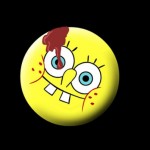 Yeah, so this is a thing that happened.
Yeah, so this is a thing that happened.
You wanna see it? Really?
Ok. You were warned. Hit the jump.
“Such sad music. The saddest thing I can imagine…
Ironically, I’d spent the last week editing my book for the sake of my old friends…I gave everyone what they wanted: a sunny remembrance. I realized that carrying all that horror inside me was a small price to pay…
The book was a smash and because it was the only real accounting of our careers, it became the truth…
…’It’ll never be like it was when it was new, but there’s still plenty of life in this old baby.'”
-Hollis Mason, Minutemen #6
Sometimes I wonder what it must be like to work at DC Comics in 2013.
There you are, at one of the inarguable pinnacles of the comic book industry. You’re working for one of the Big Two, making the best page rates available in the American comics industry, working on some of the highest profile books there are. You never have to buy your own drinks at any comic convention in the civilized world, and thousands upon thousands of aspiring creators envy you your day-to-day existence… and yet it is, where the rubber hits the road, a job. You have a boss, and you call him and he or she tells you what you are going to be working on, and you have a choice: you either do it, regardless of how inane or Sisyphean your assigned task is… or you don’t, and hope that you can keep working in your little niche without being singled out and fired.
Put on top of that the particular an individual realities of DC Comics today: you work for a company that, less than 18 months ago, blew up the underpinnings of all their books in the interest of saving them, despite being only a year or so out of Blackest Night, which put more asses in DC Comics’s panels at San Diego Comic-Con than I’d ever seen before. And since that demolition, the company has busily spent its time examining every element of those new books under a microscope, reportedly making last-minute changes and nitpicks every step of the way, causing several high-profile creators to defect to Marvel. Management has mandated new directions and has then apparently fired people when the new directions are seemingly not the right new directions, with boss-favorite creators being given the assignments in the aftermath… and all of it under the daily direction of Bob Harras, the Editor In Chief who was Marvel’s Editor In Chief during the late 1990s. So you’re working under the sure and steady hand of a man committed to raising sales at any cost – and if that cost is cancelling a book, revamping any character, or demanding a crossover, character rape or supporting character murder, so be it… all while in the back of your head, you’re hearing things like, “Clooonnnneeeee Sagaaa…. Chrooooommmiummmm covvverrrrss…”
Now let’s imagine you are one of the creators assigned to the Before Watchmen project: a project that almost no one in comics fandom wanted, if they weren’t actively opposed to it. A project that, by its very existence, implied a comic publisher that was willing to actively and enthusiastically fuck over one of its (former) A-List creators in the interest of making a little money right fucking now, long term consequences be damned. And let’s say you are asked to work on one of these Before Watchmen books while employed by a company where you can see your fellow creators being fired by email, or having their books yanked to make an opening so that one of the Golden Boys can write a book starring fucking Vibe: what do you do?
Well, if you’re Darwyn Cooke, you write a final issue of Minutemen where the narrator makes a terrible mistake, writes the truth about it as best he can while allowing himself to be bullied into severely editing himself for the good of the people around him, and makes the decision to walk away from the whole mess, so that the people foolish enough to follow him can have their chance at things.
I might be – hell, I probably am – reading too much into Minutemen #6, but as a comic book? It could make one hell of a resignation letter.
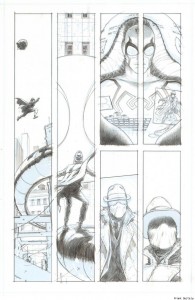 We here at Crisis On Infinite Midlives didn’t attend MorrisonCon in Las Vegas this weekend, partly because we’re still paying off our trip to the San Diego Comic-Con, and partly because no trip to a town featuring easy access to gambling and free liquor is likely to end well for us. However, that meant we missed out on some breaking news that is trickling from the convention, such as the fact that Morrison’s Multiversity series, that was initially announced for a 2009 release date, just after Infinite Crisis, is now scheduled for sometime late next year. To which I can only say: yeah, I’ll believe it when I fucking see it.
We here at Crisis On Infinite Midlives didn’t attend MorrisonCon in Las Vegas this weekend, partly because we’re still paying off our trip to the San Diego Comic-Con, and partly because no trip to a town featuring easy access to gambling and free liquor is likely to end well for us. However, that meant we missed out on some breaking news that is trickling from the convention, such as the fact that Morrison’s Multiversity series, that was initially announced for a 2009 release date, just after Infinite Crisis, is now scheduled for sometime late next year. To which I can only say: yeah, I’ll believe it when I fucking see it.
The miniseries will reportedly be eight issues, with six one-shots each focusing on a different parallel universe, with a two-part conclusion crossing over the various Earths’ heroes. And each issue looks to be packed with story, containing a 38-page primary story and an eight-page backup. And considering this thing will have been in the works for nearly half a decade by the time it hits comic stores, that seems like a fair per-book length; anything shorter might imply that Morrison had spent all this time fucking around, which seems unlikely… or even less likely, that someone at DC had actually edited the damn things.
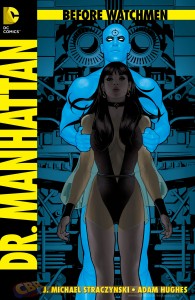 EDITOR’S NOTE: All the atoms in the test chamber are screaming at once. The spoilers… the spoilers are taking me to pieces.
EDITOR’S NOTE: All the atoms in the test chamber are screaming at once. The spoilers… the spoilers are taking me to pieces.
I’ve mentioned this before, but I think it bears repeating: Adam Hughes’s Dr. Manhattan #1 cover looks like the Good Doctor is blasting Silk Spectre right in the shitter.
Now that we have the pleasantries out of the way, we can talk about the issue itself. And a big part of me expected to not like this book. Writer J. Michael’ Straczynski’s work on fellow Before Watchmen title Nite Owl has been disappointing on a good day, and an irritating retcon of various elements of Watchmen continuity as a whole, on a bad one. Further, this book lives and dies based on Manhattan’s preoccupation on quantum theory, which is something that I can’t remember the character ever obsessing over in Watchmen, but which makes sense since Wikipedia’s article on quantum mechanics shows that not only was quantum theory viable in the mid 20th century, but that even in the early 21st century I am still too stupid to understand quantum theory.
With that said, this is an engaging book that captures the ADD nature of Dr. Manhattan’s inner dialogue in a manner that Watchmen fans will find familiar, fills out some of the backstory to the character that makes some sense, and closes on an intriguing mystery that makes me want to come back to see how it plays out. At the same time, it also somewhat overplays those character traits in ways that don’t make sense for a character who can see the totality of time, instills motivations on Manhattan that have never been mentioned before, and uses the word “box” more than an 1974 porno loop.
That’s the hell of quantum mechanics – all possibilities are real, and influenced by the observer.
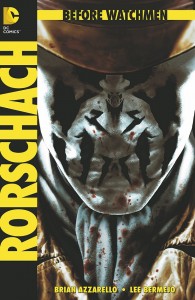 Considering how I felt about Brian Azzarello’s take on my favorite Watchmen character, The Comedian, I opened Rorschach #1 with my knife already out and sharpened. Considering how many plot and character liberties Azzarello has been taking with The Comedian, I opened this comic book fully expecting to see something like Rorschach battling Blofeld from SPECTRE in Munich while jockeying a rocketpack and firing his laser watch at the angry flying sharks. All while Rorschach weeps moronically while reciting Nietzsche to lolcats.
Considering how I felt about Brian Azzarello’s take on my favorite Watchmen character, The Comedian, I opened Rorschach #1 with my knife already out and sharpened. Considering how many plot and character liberties Azzarello has been taking with The Comedian, I opened this comic book fully expecting to see something like Rorschach battling Blofeld from SPECTRE in Munich while jockeying a rocketpack and firing his laser watch at the angry flying sharks. All while Rorschach weeps moronically while reciting Nietzsche to lolcats.
Turns out it’s not like that. Instead, Azzarello has made the connection that the Keene Act that stopped costumed adventuring in the Watchmen universe was passed in 1977, and New York City, where Rorschach was operating as a street-level crimefighter, was a terrible, terrible place in 1977. It was the New York of Taxi Driver and Son of Sam and a Times Square where a tourist could get fistfucked by a transvestite hooker instead of the retail markup at the Disney Store. It was a New York of grindhouse theaters, and Azzarello has given Rorschach a grindhouse story in which he can star. And God help me, it’s really pretty damn good.
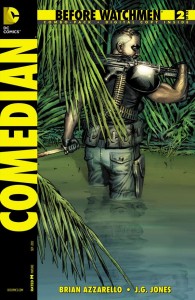 EDITOR’S NOTE: Whatever happened to The American Dream? Spoiler alert!
EDITOR’S NOTE: Whatever happened to The American Dream? Spoiler alert!
So The Comedian started the Vietnam War. Must be Tuesday.
The Comedian #2 is better than the first issue, but then again, it almost had to be. Seeing writer Brian Azzarello having Eddie Blake simpering around the Kennedys and doing things that blithely and utterly flew in the face of some of Alan Moore’s existing story canon were almost more than this old school Comedian fan could bear. This issue improves on the ruins of the first, by getting The Comedian the fuck away from politicians and into the jungle of pre-Gulf of Tonkin Vietnam, allowing the character to show a little more of the savagery and moral ambiguity that we’d come to expect from the original Watchmen.
Of course, it also include’s Azzarello’s apparent burning compulsion to put The Comedian at the center of every major event in American history that has occurred since 1939. In the first issue, it was the death of Marilyn Monroe, and here it’s the Ali-Liston fight and the literal beginning of the Vietnam War. If The Comedian hadn’t been killed in the original Watchmen, I’d be afraid that Azzarello would end issue 6 with Blake at the discovery of the Higgs Boson snarling, “You’re turning into a flake, Doc.” Actually, that’s probably a hasty argument; after that first issue, I’m not yet convinced that Azzarello won’t decide that the murder of The Comedian isn’t really Watchmen canon. But I digress.
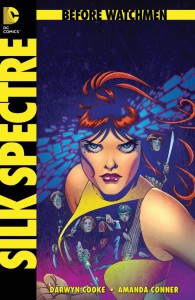 Simply put, and without question: Silk Spectre #2 is the best issue of Before Watchmen so far.
Simply put, and without question: Silk Spectre #2 is the best issue of Before Watchmen so far.
It does everything you’d expect from a Watchmen prequel book, particularly one that isn’t endorsed by the original creators: it follows the original book’s visual, nine-panel format, it pays homage to Moore’s original writing style of having the words directly reflect the visuals in the panel, and it expands the Watchmen universe by exploring niche, side subjects that it would never occur to me to wonder about until I saw those explorations here. By mining the original work’s edges while paying tribute to its written and drawn style, it does what a prequel should do: build upon the original without superceding it. It is the first Before Watchmen book that I plainly and simply liked.
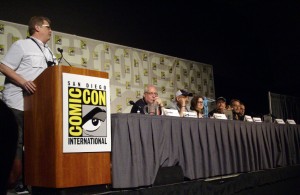 I expected things to be a little more contentious than they wound up being at DC Comics’s Before Watchmen panel yesterday.
I expected things to be a little more contentious than they wound up being at DC Comics’s Before Watchmen panel yesterday.
After all, this is Comic-Con. It is packed to the gills with rabid fanboys and fangirls, many of whom were swirlied in junior high school (Hi, Paul Jameson! I make a comfortable living in the software industry now! How’s that A in woodshop treating you, fucker?) and now that they have strength in numbers, are itching for a fight. This convention has fundraisers for Jack Kirby, panels dedicated to pointing out the injustice of Bill Finger not getting enough credit for co-creating Batman, and a panel called The Most Dangerous Women in Comics. It is a place where a lone nut in a Batgirl suit can change the course of an entire comics company, and come back the next year bearing gifts for the creators and none for the thousand or so paying customers whose convention experience she fucked with last year in order to further a personal agenda. In short: this is Angry Fanboy Central, and if there was a place for them to show their colors, it was this panel.
But that didn’t happen. Sure, the panel started a little bit late, and the whole Quentin Tarantino announcement smack in the middle sucked up some question time, so maybe the slavering, angry, “You fucked Alan Moore!” guy just didn’t get his turn at the microphone. The people who did get a turn were generally really enthusiastic about the whole Before Watchmen project; one fan flat-out said that he was one of those “keyboard commandos” who ranted against the whole project, but wound up really getting sucked into it. Hell, the entire Alan Moore elephant in the room was only addressed once by anyone in the crowd… and it was a guy who was hoping that DC could get Moore to work on a Watchmen sequel.
How’d that turn out? Well, let’s watch!
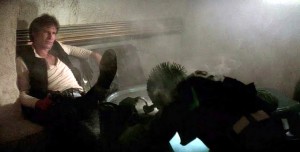 With Rob and Amanda waist deep in nerd sweat out at San Diego Comic-Con, I’m left to my own thoughts and that’s not usually a good thing.
With Rob and Amanda waist deep in nerd sweat out at San Diego Comic-Con, I’m left to my own thoughts and that’s not usually a good thing.
In an earlier post, Rob alluded to my very subtle unhappiness with what DC, and in particular Rob Liefeld, did to a couple of my favorite New 52 characters. I was very disappointed with what happened with Voodoo when Ron Marz was relieved of duty. But when Liefeld took over Grifter, I nearly ripped the book in half. I’ve tried writing a couple reviews of the recent iterations of these books, but I find myself digressing into a raving ball of spit and bile. And after some soul searching, I had an epiphany….
I don’t like superheroes…
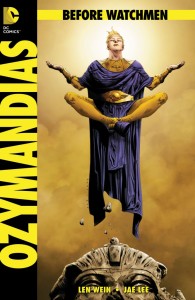 We’re only about a month into the rollout of Before Watchmen, but I have already learned that, when I open one of these issues, I should expect to experience a strong emotional reaction. Granted, that reaction is normally somewhere in between mild bemusement and screeching pre-psychotic rage, but a reaction nonetheless.
We’re only about a month into the rollout of Before Watchmen, but I have already learned that, when I open one of these issues, I should expect to experience a strong emotional reaction. Granted, that reaction is normally somewhere in between mild bemusement and screeching pre-psychotic rage, but a reaction nonetheless.
No matter what you think about Before Watchmen as a project, you have to admit that there hasn’t been an issue released so far where you can’t say that the creative team wasn’t swinging for the fences. Sure, Comedian was a hot mess of mischaracterization and plot points that directly conflicted with Moore’s original, and Minutemen seemed to think that Hooded Justice, a former circus strongman, had Moves Like Jagger If Jagger Studied Ninjitsu With Bruce Lee, but there was never any doubt that Azzarello, Cooke and the rest weren’t trying their damnedest to add something substantial to the Watchmen mythos… even if what they’re adding at best isn’t what anyone asked for, and at worst isn’t what anyone ever wanted. You gotta admit they’re trying to bring something new to the party.
At least, you had to admit that. Because this week brings us Ozymandias #1, written by Len Wein with art by Jae Lee. And it is the first Before Watchmen comic that adds literally almost nothing to the story and character that came before. This book almost exclusively reiterates character and story beats directly from the original Watchmen story, giving us very little beyond them… but to be fair, it does provide a bit of additional character illumination and story extension. Unfortunately, the character that is illuminated is Ralphie, and the story it extends is A Christmas Story.